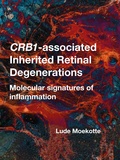CRB1-associated Inherited Retinal Degenerations
Molecular signatures of inflammation

Moekotte, Lude
- Promoter:
- Prof.dr. M.M. (Mies) van Genderen & Prof.dr. J.H. (Joke) de Boer
- Co-promoter:
- Dr. J.J.W. (Jonas) Kuiper
- Research group:
- Boer Kuiper
- Date:
- September 26, 2024
- Time:
- 12:15 h
Summary
The Crumbs homolog 1 (CRB1) gene is crucial for retinal photoreceptor integrity. Pathogenic variants in CRB1 cause inherited retinal dystrophies (CRB1-IRDs), leading to photoreceptor cell death and early visual impairment, with varying clinical phenotypes. Vitreous inflammation and cystoid macula edema (CME) in CRB1-IRD patients suggests involvement of inflammatory pathways, but the molecular underpinnings are significantly underexplored. In this thesis, we investigated the possible changes in the immune system in human patients with CRB1-IRDs using immune profiling techniques.
Using flow cytometry, we identified an expansion of T cells with specific tissue-homing markers and a decrease in plasmacytoid dendritic cells (pDCs) in peripheral blood of CRB1-IRD patients compared to controls. It appears that CRB1-IRDs exhibit inflammatory pathways similar to those seen in autoimmune diseases.
Blood plasma proteomics revealed elevated complement factor H (CFH) and related complement components, indicating the involvement of complement activation in CRB1-IRDs. In addition, our research shows that genetic linkage between CRB1 and CFH/CFHR genes may in part influence this phenomenon.
We further showed that CRB1-IRD patients have lower neuroprotective secondary bile acid concentrations in blood plasma, which strongly suggest altered gut microbiota. We also detected elevated cholesteryl esters and glycerophospholipids in patients, indicating a protective response to neurodegeneration.
Our study revealed that multiple inflammatory pathways are involved in the disease mechanisms of CRB1-IRDs that go beyond inflammation in the eye.